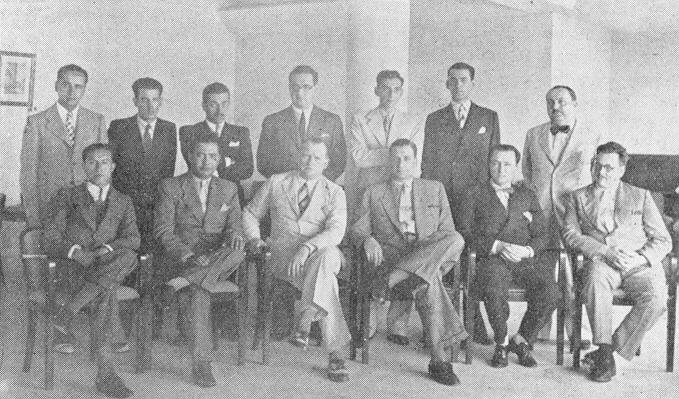
When contacting us by e-mail, correspondents are asked to include their name and full postal address and, when providing information, to quote exact book and magazine sources. The word ‘chess’ needs to appear in the subject-line or in the message itself.
| First column | << previous | Archives [16] | next >> | Current column |
A rarely-seen group photograph from the Carrasco tournament in Montevideo, March 1938:

Seated (left to right): R.
Letelier, C. Guimard, A. Alekhine, R. Bensadón, V. Fenoglio and
A. Olivera.
Standing: R. Flores, J. Cánepa, W. Cruz, J. Balparda, E.
Rotunno, C. Maderna and R. Grau
Source: El Ajedrez Americano, April 1938, page 113.
Michael Clapham (Ipswich, England) writes:
‘Further to your feature article on chess prodigies, the players listed below all represented their countries in Olympiads between 1927 and 1950 while aged 18 or under. This information has been compiled from the dates of birth recorded in Chess Personalia A Biobibliography by J. Gaige (Jefferson, 1987) for the players listed in Chess Olympiads by A. Földeák (Budapest, 1966).
- Erich Eliskases was 17 when he represented Austria in the 1930 Olympiad in Hamburg.
- Reuben Fine and Albert Simonson were both 18 when they represented the USA in the 1933 Olympiad in Folkestone.
- László Szabó was 18 when he represented Hungary at the 1935 Olympiad in Warsaw.
- Daniel Yanofsky was only 14 when he made the highest percentage on second board representing Canada in the 1939 Olympiad in Buenos Aires.
- Carlos Salazar was 14 or 15 when representing Guatemala at the 1939 Olympiad. I have assumed here that the Salazar recorded in Chess Olympiads is the C. Salazar of Guatemala, born in 1924, recorded in Chess Personalia (exact date of birth not given), but I cannot be certain about this.
- Larry Evans was 18 when he represented the USA in the 1950 Olympiad in Dubrovnik.’
Given that 1 d4 d5 2 c4 e5 is known to have been played in the 1880s and 1890s, we are not sure what to make of the following item on page 390 of the Literary Digest, 29 September 1900:
‘The St Paul Gambit
Several players in the Munich tournament played a counter-gambit to the Queen’s Gambit Declined with considerable success. This move is Black’s second ...e5 instead of the usual ...e6. The game goes like this: 1 d4 d5 2 c4 e5 3 dxe5 d4, etc.
This variation was discovered by George B. Spencer, St Paul, Minn., and named by him the St Paul Gambit. It has not met with great favor as it was considered, if not unsound, very risky, but Marshall, who first used it in match-play, pronounces it all right.’
Michael McDowell (Westcliff-on-sea, England) quotes from page 20 of The Problem Art by Thomas B. Rowland and Frideswide F. Rowland (published in 1887):
‘Some years back there was a strong prejudice against self-mate problems, and even still there are a few who are not favourably disposed towards them, and who declare that they are “not chess”. The inaccuracy of such an allegation becomes manifest on reflecting that forcing an opponent to give mate is and has been recognized as odds given by an advanced player to a beginner, or weak player. At a chess meeting recently held at Bradford, Dr Zukertort not only gave these odds but actually specified the pawn which he would compel his opponent, Mr Mark Dawson, to mate with. The feat was successfully accomplished by the champion.’
Mr McDowell comments:
‘I wonder if the score of the above-mentioned game exists. The only game at “self-mate odds” of which I am aware is the Paris v Marseilles game given on pages 216-217 of Chernev’s The Chess Companion.’
We note that in the second (1897) edition of the Rowlands’ book the references to Bradford and Dawson were deleted, and that the passage finished (after ‘or weak player’): ‘Dr Zukertort not only gave these odds but actually specified the pawn which he would compel his opponent to mate with.’
Which player drew this picture of Alekhine?
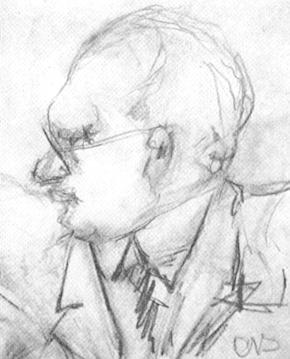
Three confusing quotes:
- ‘When you are lonely, when you feel yourself an alien in the world, play chess. This will raise your spirits and be your counselor in war. – Aristotle.’
Source: Chess Quotations from the Masters by H. Hunvald (Mount Vernon, 1972), page 5.
- ‘I greatly admire a fellow who goes about the whole day with a well-fed stomach and a vacuous mind. How can one ever do it? I would rather that he play chess, which would seem to me to be better. Confucius – from Book 17, about 200 [sic] B.C.’
Source: CHESS, June 1984, page 21. See also pages 62-63 of The Genealogy of Chess by D.H. Li (Bethesda, 1998) and pages 49-50 of The Personality of Chess by I.A. Horowitz and P.L. Rothenberg (New York, 1963) .
- ‘The first known historical document connected with chess is an inscription on a tablet in a pyramid at Gizeh, dating back to 3,000 years before Christ.’
Source: Wonders and Curiosities of Chess by I. Chernev (New York, 1974), page 177.
In the discussion on the nineteenth-century blind player ‘G. Lum(b)ley’ in C.N.s 3426 and 3443 very little about him could be stated positively. Now, though, Owen Hindle (Cromer, England) has found out more:
‘The chess column in Cassell’s Illustrated Family Paper for 17 March 1855, page 87, contains the following in the “Answers To Our Chess Correspondents” section:
“GEORGE MADDISON. – The specimens sent exhibit some talent for the construction of chess problems. They are not, however, sufficiently difficult for publication. We are much gratified that your friend, who as you state, is so seriously afflicted, can find solace in this intellectual pastime. We are somewhat curious to know by what means he has acquired a knowledge of the game.”
(The columns for 7 April 1855, page 111, and 2 June 1855, page 175, mention further communications from George Maddison, but do not provide answers to the above question.)
In the columns for 7 April 1855, page 111, and 14 April 1855, page 119, George Lumley is noted as a successful solver of two chess problems.
The 1851 British Census lists a George Maddison, aged 31, as a teacher of basket-making at the Charles Road Blind Asylum, Old Trafford in the township of Stretford.
Amongst the “inmates”, as they are described, is George Lumley, aged 15, a basket-maker, born in Manchester.
The 1861 Census has George Lumley, aged 24, born in Manchester, living as a boarder in Wellington Street in the Holy Trinity parish of Kingston upon Hull. He is described as a Chess Tutor, and it is noted that he is “Blind not from birth”.’
Leonard Barden (London) writes regarding William Winter:
‘I played Willie in the British championship in Buxton in 1950, and my strongest memory is that he showed himself a gentleman. I was in time-pressure with a lost position when he inadvertently allowed a threefold repetition. I claimed, he demurred, and as we waited for the arbiter I was overcome by guilt (I had learnt much from his Chess for Match Players) and confusion, and made a move. Then I realized again that I was right after all. Willie still agreed the draw even though I had invalidated my claim.
I never thought of Willie as “short”. Heights generally were lower then than now, but I guess he was about five feet five or six (1 metre 65-67). The group photograph taken at Nottingham, 1936 shows him looking very unhappy with his legs intertwined, but not appearing specially small.
William Winter
I did think Flohr (whom I also played, at Hastings, 1961-62) a small man, and believe his height may have helped him (less strain on the neck muscles) in large simuls, where he had a big reputation. I never saw Flohr give a simul, but witnessed Karpov twice ambushed by very strong teams of English juniors and thought that he too was helped by below-average height. In fact, Karpov was the best I ever saw in a large simul.’
We have now found a full-length picture of William Winter, taken during the Nottingham, 1946 tournament and given opposite page 49 in the book on the event published the same year by CHESS, Sutton Coldfield:
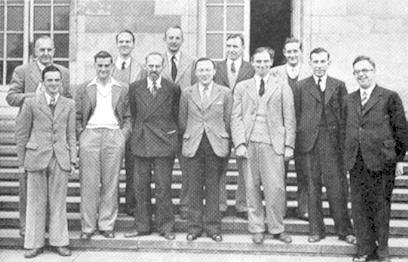
Front row, left to right: R.G.
Wade, F. Parr, W. Winter, R.F. Combe, C.H.O’D. Alexander, H.
Golombek, G. Abrahams
Behind: G. Wood, R.J. Broadbent, P.S. Milner-Barry, A.R.B.
Thomas, B.H. Wood
This was taken at the same place as one of the most famous chess group photographs: Nottingham, 1936.
Miquel Artigas (Sabadell, Spain) writes:
‘The international chess tournament held in Sabadell (Spain) on 2-10 August 1945 is one of the lesser-known events in which Alekhine played. As far as I am aware, the main sources of information are the books on Alekhine by P. Morán (Spanish and English editions) and by L.M. Skinner/R.G.P. Verhoeven. Surprisingly, in the 367-page book Federació Catalana d’Escacs 75 anys d’historia (Barcelona, 2001) I have found (on page 63) only eight lines on the tournament, and not even the crosstable, which is given in the other books mentioned above. Nor could I find anything about the tournament in Ajedrez Español, which was the only chess magazine published in Spain at that time.
However, in the archives of the Club d’escacs Sabadell (the Sabadell chess club) there are four photographs from the tournament:
Vallés v Lupi
Terrazas v Ros
Mena v Pérez
General view of the playing area, with Alekhine on the far right
These pictures are probably part of a bigger set (as it is surprising that there are not more, and better, photographs of Alekhine or even Medina). The Club d’escacs Sabadell was founded in December 1935 and has often changed its premises, especially in recent times.
Have the other archives been lost or can more be found out about the tournament? At the moment, four of Alekhine’s game-scores are missing, and I would appreciate any new information about the event.’
The four photographs provided by our correspondent are reproduced above with the permission of the President of the Club d’escacs Sabadell, Mr Oscar Oliva.
We are puzzled by the picture of Terrazas, because on page 227 of the English edition of Morán’s book on Alekhine the translator, Frank X. Mur, affirmed that Terrazas was aged 11 at the time of the tournament.
Marek Soszynski (Birmingham, England) asks:
‘Are there any games extant by Joseph Hunt (1851-1920) supporting his being described as “The Originator of the Hunt Opening (1 b4)”?’
We have yet to find any such games, and shall welcome readers’ assistance.
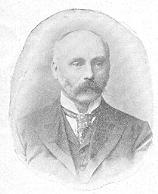
Joseph William Hunt
It was in the 1890s that the opening gained in familiarity (after Schlechter’s quick defeat of Fleissig in 1893, a famous game often misdated 1895), but at that time the heading ‘Irregular Opening’ was generally used. Hunt’s name was associated with 1 b4 only occasionally (e.g. on page 203 of La Stratégie, 15 July 1895). On the other hand, neither the obituary of Hunt in the BCM (July 1920, page 227) nor the autobiographical feature on pages 384-387 of the September 1902 issue mentioned the opening. The latter item does, however, contain the following information:
‘The only public tournament I ever entered was that of the Counties’ Chess Association, held at Oxford. There I was fortunate enough to draw with the Revs. Owen and Skipworth, and beat Trenchard, though I was nowhere after all.’
That tournament was in 1891, but did Hunt play 1 b4 in any of his games?
Following on from the previous item, here are some references concerning the opening move 1 b4:
Further information is sought. In particular, was Skipworth the first to play 1 b4, in 1868, and what more is known about the involvement of Hunt and Englisch?
For the benefit of Everyman Chess, below is a repeat of C.N. 3686, which was posted on 2 April 2005.
We note from Amazon.com that Everyman Chess plans to publish a book entitled Rudolph Spielmann Master of Invention by Neil McDonald in December 2005. There should, therefore, be time for the master’s forename to be corrected to Rudolf.
Rudolf was the spelling used by Jack Spence in his Spielmann trilogy, although confusion arose when the Chess Player became the publisher (i.e. with Rudolph on the front cover and Rudolf on the title page). In contrast, Eric Schiller’s 1996 book on Spielmann had Rudolf on the front cover and Rudolph on the title page (as well as everywhere else). However, in all the books, signatures, etc. of Spielmann himself that we have seen he used Rudolf, and no justification for Rudolph is apparent. Similarly, it is unclear on what grounds A. Soltis often, though not always, writes ‘Karl’ Schlechter.
The January-February 1907 issue of the Wiener Schachzeitung (pages 8 and 10) had photographs of Schlechter and Spielmann with their signatures:
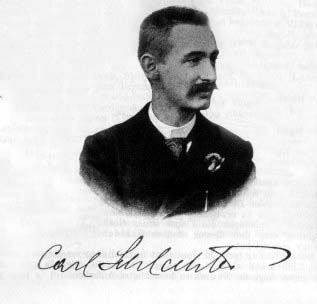
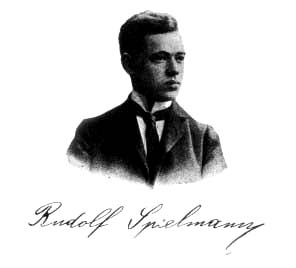
Can White win?
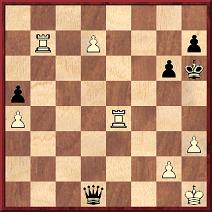
Mark N. Taylor (Mt Berry, GA, USA) writes:
‘I can offer a clarification of the Confucius “pre-chess” chess quote. James Legge’s translation in Book XVII Chapter XXII on page 329 of Confucian Analects (1893 edition, reprinted by Dover Publications, Inc., New York in 1971) reads:
“The Master said, ‘Hard is it to deal with him, who will stuff himself with food the whole day, without applying his mind to anything good! Are there not gamesters and chessplayers? To be one of these would still be better than doing nothing at all.”
Legge admits in a note that “gamesters” (bo – to use the Pinyin transliteration) is a best guess. He also notes that both Chinese Chess and Go can be referred to here with the single term i.
On pages 215-216 of The Analects of Confucius (1938 edition, reprinted by Vintage Books, New York in 1989) the translator Arthur Waley put:
“Are there not games such as draughts? To play them would surely be better than doing nothing at all.”
Waley took both bo and i to refer to playing board games and suggested that i could be identified with Go. The character i is a verb, meaning “ to play a board game”, without necessarily specifying which. Thus the term chess in this passage has been interpolated by the translators.’
Having examined 1 b4 in C.N.s 4009 and 4010, we turn now to 1...b5. The examples below go as far as the 1930s and omit relatively well-known games, the most famous probably being M. Euwe v G. Abrahams, Bournemouth, 1939.
Miquel Artigas (Sabadell, Spain) has discovered two further photographs taken at Sabadell, 1945:
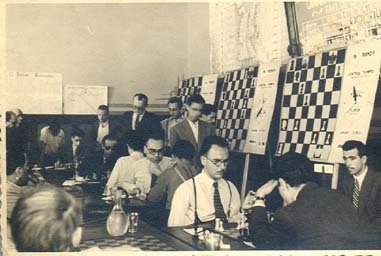
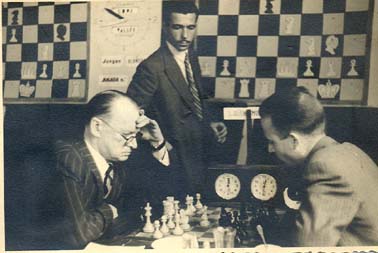
Then there is the Terrazas mystery to which we drew attention in C.N. 4008. On page 227 of A. Alekhine Agony of a Chess Genius by P. Morán (Jefferson, 1989) the translator, Frank X. Mur, added the following note at the end of the Terrazas v Alekhine game:
‘Alekhine’s victim was 11 years old. Years later he wrote: “I only recall that the imposing figure of an Alekhine made one play with a deep reverential awe, especially at that age.” – Filiberto Terrazas to Frank X. Mur, letter dated 19 January 1979.’
As mentioned in the earlier C.N. item, it may be wondered how Terrazas could have been only 11 years old, given the photograph of him provided by Mr Artigas. A further consideration is that the original Spanish edition of Morán’s book (Madrid, 1972) gave no forename, or even initial, for Terrazas. So was he really Filiberto? A (Mexican) player of that name certainly existed, but Mr Artigas writes:
‘In Sabadell there was a player named Teodoro Terrazas Elizando. In the 1944-45 season he was registered with the Federación Catalana de Ajedrez as a first-category player for the Sabadell club, and I have been lucky enough to find his identity card for that season. I am almost sure that he was the participant in Sabadell, 1945, but further checking is required.’
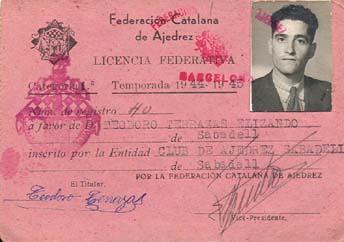
As if one Sabadell mystery (the Terrazas matter) were not enough, we revert here to the second photograph in C.N. 4015, of which a larger version is given now:
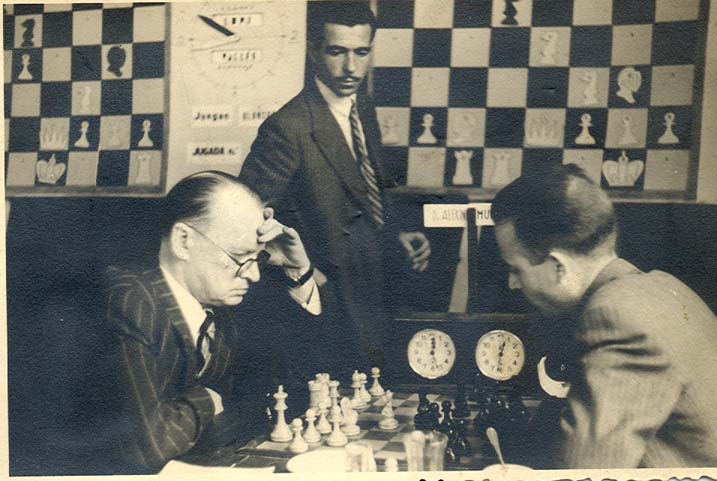
From the identification of the players at the bottom of the demonstration board it would seem clear that Alekhine was facing Muñoz, yet the position bears no relation to that game as presented on pages 231-233 of A. Alekhine Agony of a Chess Genius by P. Morán (1 d4 d5 2 c4 e6 3 Nf3 Nf6 4 Bg5 Bb4+ 5 Nc3 dxc4 6 e4 c5 7 Bxc4 cxd4 8 Nxd4 Qa5 9 Bxf6 Bxc3+ 10 bxc3 Qxc3+ 11 Kf1 Qxc4+ 12 Kg1 O-O 13 Qg4 g6 14 e5 Nc6 15 Nf5 Resigns). Nor have we been able to match the position in the photograph with any other game.
Is it possible, therefore, that Morán’s book was mistaken about the score of the Alekhine v Muñoz game? Investigating such a matter is difficult, not least because his book failed to supply sources. The same 15-move game was also given as Alekhine v Muñoz on page 728 of Alexander Alekhine’s Chess Games, 1902-1946 by L.M. Skinner and R.G.P. Verhoeven (Jefferson, 1998), but the source specified was merely Morán’s book.
On the other hand, if Morán was correct that the 15-move game occurred between Alekhine and Muñoz, how is the above photograph to be explained?
C.J.S. Purdy was a consummate chess teacher, and it is therefore of interest to note his choice of ‘the very best beginner’s book’, on page 157 of Chess World, October 1963. Below is an abridged version of his remarks:
‘Is there one beginner’s book that is better than all the others? ... Up till now we have never had a sure answer ... Now we have. It is Learn Chess by C.H.O’D. Alexander and T.J. Beach. ... There is not one ambiguous or difficult sentence, or even word, in the whole book. ... We seldom praise a book so highly. We think most chess books have something good in them and are worth reading despite a percentage of twaddle. But here is a book which, for the players it’s intended for, is 100% good. Don’t forget, it is for genuine beginners, not for near-average players. It is excellent for children, and excellent for adults.’
Learn Chess was first published in 1963, in two volumes. It has been republished a number of times, e.g. by Cadogan Chess in 1994 as a single volume (algebraic notation).
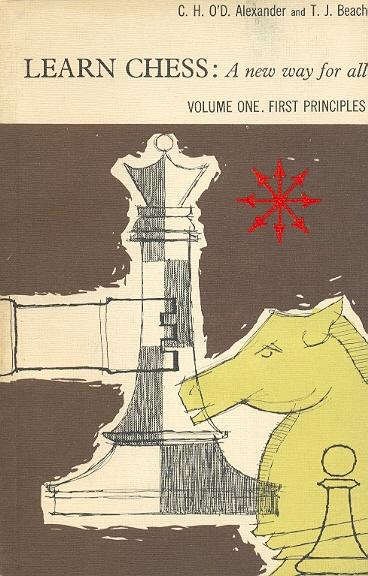
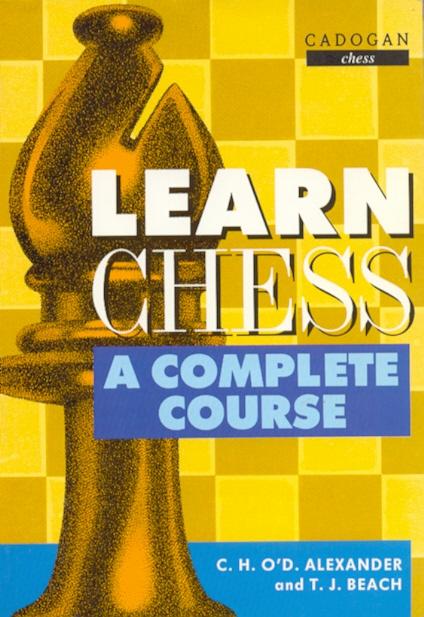
John Hilbert (Amherst, NY, USA) provides an unidentified newspaper’s report about Pillsbury in 1905:
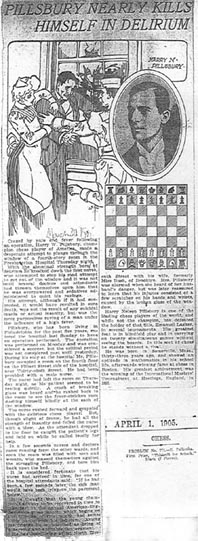
The text can be read in Pillsbury’s Torment, an addition to our feature articles. Readers should, though, bear in mind the quoted statement of Walter Penn Shipley that the newspaper reports were ‘grossly exaggerated’.
Bernd Graefrath (Mülheim an der Ruhr, Germany) points out that there was a brief feature on ‘Inverse Chess’ (including the score of the Paris v Marseilles game) on pages 464-465 of Brentano’s Chess Monthly, January 1882. The text reads:
‘Playing chess to lose, that is to compel your adversary to mate you, is practised to a considerable extent in Europe, especially in France. The game has never been recognized in this country, and we do not know that any chess periodical has published any specimens of this method of play. Taking advantage of the good nature which we know usually prevails at this season we venture agere libertate Decembri, and present our readers with a curiosity in the shape of one of those games à qui perd gagne. It is one of several which were played by correspondence a year or two ago between Paris and Marseilles. Paris gives the queen, and Marseilles undertakes to compel self-mate.’
We note that the following brief report on page 149 of the April-May 1879 La Stratégie offered to make the above-mentioned game-score available to readers upon request and, furthermore, named the players:
‘Nous avons reçu de M. A. Demonchy de Marseille une très curieuse et intéressante partie inverse jouée par correspondance avec M. A. Nicolas de Paris. Ce dernier qui rendait la dame a été obligé de faire mat au 69ème coup. M. Demonchy ayant mis à notre disposition quelques exemplaires autographiés de cette partie, nous les enverrons gratuitement aux premiers abonnés qui nous la demanderont.’
See also this article.
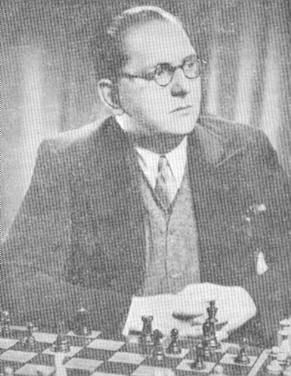
Moshe Czerniak
Avital Pilpel (Haifa, Israel) sends the following game, which he found in Moshe Marmorosh’s chess column in Davar, 14 April 1939:
Victor Winz – Moshe Czerniak
First Lasker Chess Club Championship, Tel Aviv, April 1939
Grünfeld Defence
1 d4 Nf6 2 c4 g6 3 f3 d5 4 cxd5 Nxd5 5 e4 Nb6 6 Nc3 Bg7 7 Be3 O-O 8 f4 Nc6 9 d5 Nb8 10 a4 e5 11 a5
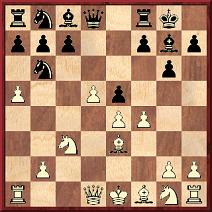
11...exf4 12 axb6 fxe3 13 Rxa7 Qh4+ 14 g3 Bxc3+ 15 bxc3 Qxe4 16 Nf3 Bg4 17 Rxa8 Bxf3 18 Qd3 Qe5 19 bxc7 Qxc7 20 Rg1 Qb6 21 g4 Rd8 22 Rg3
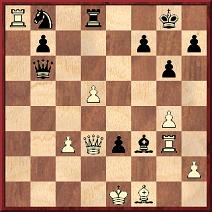
22...Rxd5 23 Rxb8+ Kg7 24 Rxf3 Rxd3 25 Bxd3 Qc7 26 Re8 Qxc3+ 27 Kf1 Qxd3+ 28 Kg2 Qd2+ 29 Kg3 e2 30 Rfe3 Qe1+ 31 Kh3 Qf1+ 32 Kg3 Qg1+ 33 Kh3 Qf2 34 R8e5 b5 35 g5 h5 36 R5e4 b4 37 Rxe2 Qf3+ 38 Kh4 b3 39 R2e3 Qf2+ 40 Kh3 b2 41 White resigns.
John Hilbert (Amherst, NY, USA) writes:
‘Over 55,000 photographs from the Chicago Daily News for 1902-33, now the property of the Chicago Historical Society, are available at this webpage. A simple search for “chess” listed 38 images, including pictures of Lasker, C. Medinus, Sidney Johnston, C.W. Parks, Charles Phillips, Louis Uedemann, Sammy Rzeszewski, Frank Marshall, Harry Lee and Emil Kemény. The quality is exceptional, as they are taken from original negatives.’
Michael McDowell (Westcliff-on-sea, England) offers some observations on problem compositions in Pal Benko My Life, Games and Compositions by Benko and Jeremy Silman (Los Angeles, 2003):
- ‘Page 570 No. 5. The comment is incorrect. There are eight promotions but only four mates: 1...c1(Q)/cxd1(N) 2 Qxe2; 1...c1(N)/cxd1(Q) 2 Qb4; 1...exd1(Q)/e1(N) 2 Qe3; 1...exd1(N)/e1(Q) 2 Rxc2.
- Page 571 No. 7. The comment on page 569 referring to this problem is rather odd, as Mansfield had combined white and black organ pipes in the following problem: Comins Mansfield, 1st Honourable Mention, The Problemist, 1961. 4Q3/2Kp1p2/1P1N1P1b/p2k3r/P3p2r/P3p2r/n3p2b/4P3/BRRB1N2 #2. In both problems there are mates prepared for all black moves in the diagram. Benko’s key simply maintains the Zugzwang, whereas Mansfield’s key 1 Rb3 changes the mate for 1…N(x)b1 from 2 Bb3 to 2 Rb5. Mansfield’s setting, however, suffers from the severe defect that the d1 bishop is useless after the key, and the problem is sound without it. Benko’s is much the better problem.
- Page 578 No. 42. Anticipated by Michael Lipton, Jerusalem Post, 1960. R7/B7/B7/16/2p4r/8/k1K5 #2. 1 Bb6.
- Page 587 No. 74. Anticipated by W.A. Shinkman, Tiffin Tribune, around 1898 (source as given on page 82 of The Golden Argosy) 8/7p/8/7k/5K2/8/6R1/8 #3. 1 Rg1 h6 2 Rg2.
- Page 588 No. 80. The manoeuvre was shown by J. Jespersen, Vor Tid, 1883. 16/1K6/8/k7/8/1R6/8 #6. 1 Rb5 2 Ka5 3 Ka4 4 Kb3 5 Rc5.
- Page 648 No. 267. Incorrect source. Published as an original in The Problemist, July 1976.’

This sketch of Alekhine was by A. Baratz, who gave it in his book Testament d’Alekhine (Paris, 1971). His drawings of Bernstein and Tartakower appeared on pages 69 and 99 of With the Chess Masters by G. Koltanowski (San Francisco, 1972). On page 99 Koltanowski called him ‘M. Baratz’ and, on page 146, ‘Andre Baratz’. Page 753 of Le guide des échecs by N. Giffard and A. Biénabe (Paris, 1993) gave his forename as ‘Alexandre’, whereas the entry (one line) on page 31 of the Dictionnaire des échecs by F. Le Lionnais and E. Maget (Paris, 1967) provided no forename or even initial. Jeremy Gaige’s Chess Personalia (Jefferson, 1987) had ‘Abraham’.
Baratz was shown in the group photograph of Hyères, 1927 (C.N. 3606), and below is a picture taken at the previous year’s tournament (which he won), our source being The Book of the Second Annual Chess Congress Hyères, 1926:
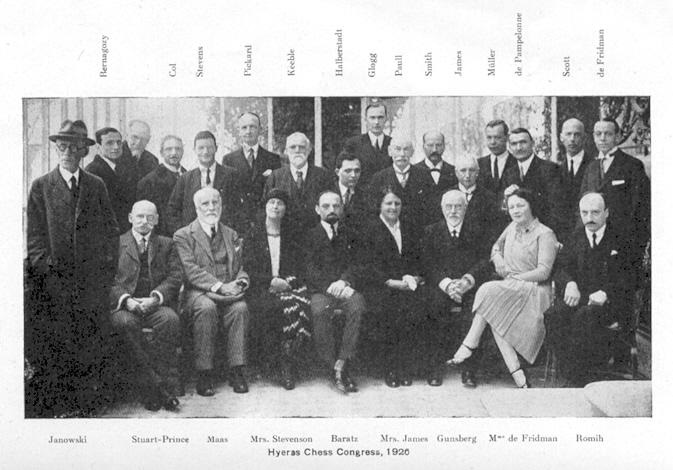
From Steve Wrinn (Homer, NY, USA):
‘Alekhine to me has always possessed a rather protean image in photographs: in certain shots he appears handsome, confident and self-possessed, while in others his appearance is very much the reverse. Two striking examples of this contrast are the photograph of Alekhine in the Berne, 1932 tournament book and the one of him at Nottingham, 1936 which appeared in the obituary article on page 16 of the April 1946 Chess Review:
The former is, in my opinion, one of the best of Alekhine, and shows a self-assured and still somewhat youthful champion at the height of his powers. Those are hardly adjectives one would apply to the man in the Nottingham photograph just four years later (four years which, of course, included the loss of the world championship and a less-than-optimal lifestyle). To judge from the position on the board, the Nottingham photograph was taken during Alekhine’s first-round game against Flohr, just after the “lapsus manus” 4 Bd2 and Flohr’s reply 4...dxe4.’
Below we add another Nottingham, 1936 photograph, from page 229 of the October 1936 Chess Review:
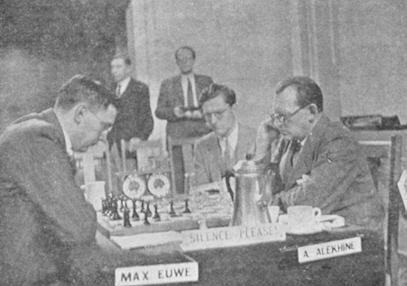
The caption stated that the seated onlooker was the Review’s correspondent Paul Hugo Litwinsky (who later changed his surname to Little).
Our correspondent also writes:
‘On pages 90-91 of Achieving the Aim (Oxford, 1981) Botvinnik writes about visiting Triberg in 1973 and being shown a then-unpublished photograph of Bogoljubow and Alekhine, taken around 1922. This picture, says Botvinnik, gave him a better understanding of the young Alekhine, a far different man from the one he met in person in 1936-38:
“Alekhine was gesticulating with his right hand and, with raised eyebrows and a sly look on his face, was relating something. ... There was so much expressiveness, humour, spiritual strength and calm certainty in his appearance that I understood how he could withstand the severity of the struggle with the great Cuban and take the world championship.”
I wonder if this photograph has been published anywhere since 1973. It would be a delight to see it.’
Still on the subject of Alekhine pictures, the two below are worth comparing:
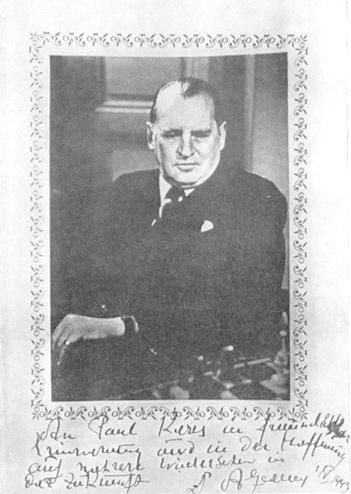
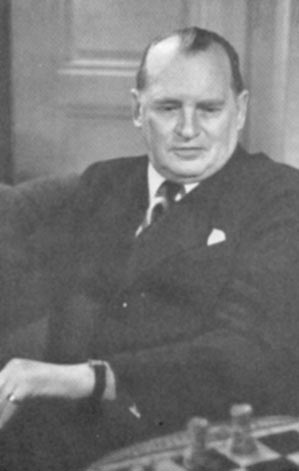
The first, a rare instance (from 1943) of one leading master inscribing a photograph of himself to another, comes from Meie Keres by V. Heuer (Tallinn, 1977), whereas the second is the frontispiece of the first volume of Alechinův šachový odkaz by A. Kotov (Prague, 1956).
The following is the start of a letter from Morphy to D.W. Fiske dated 25 January 1858 which was reproduced on pages 26-28 of “Our Folder” (the Good Companion Chess Problem Club), 1 November 1920:
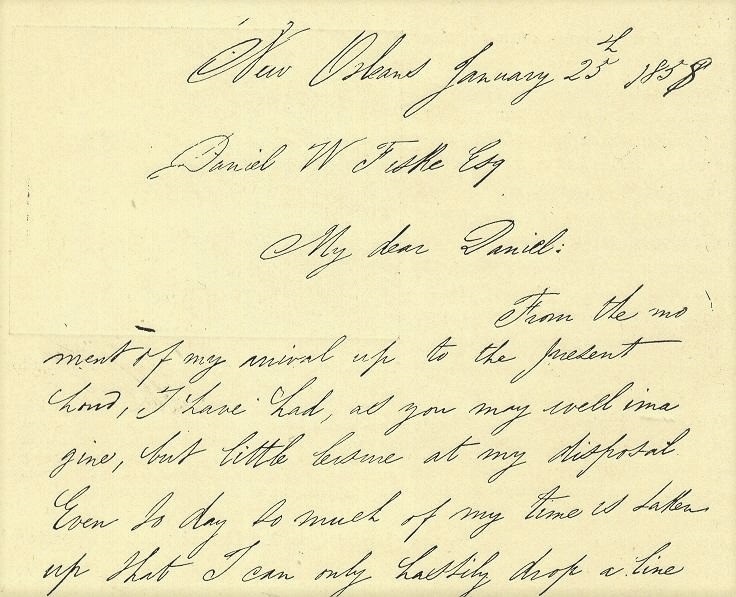
For a transcript of the full letter, see page 89 of David Lawson’s book on Morphy.
A tin of biscuits seemed to have been posted to us, but no. The light 21cm x 21cm metal box contained a 64-page introduction to chess (by Gareth Williams, with many colour illustrations), a folded board and a set of plastic pieces.
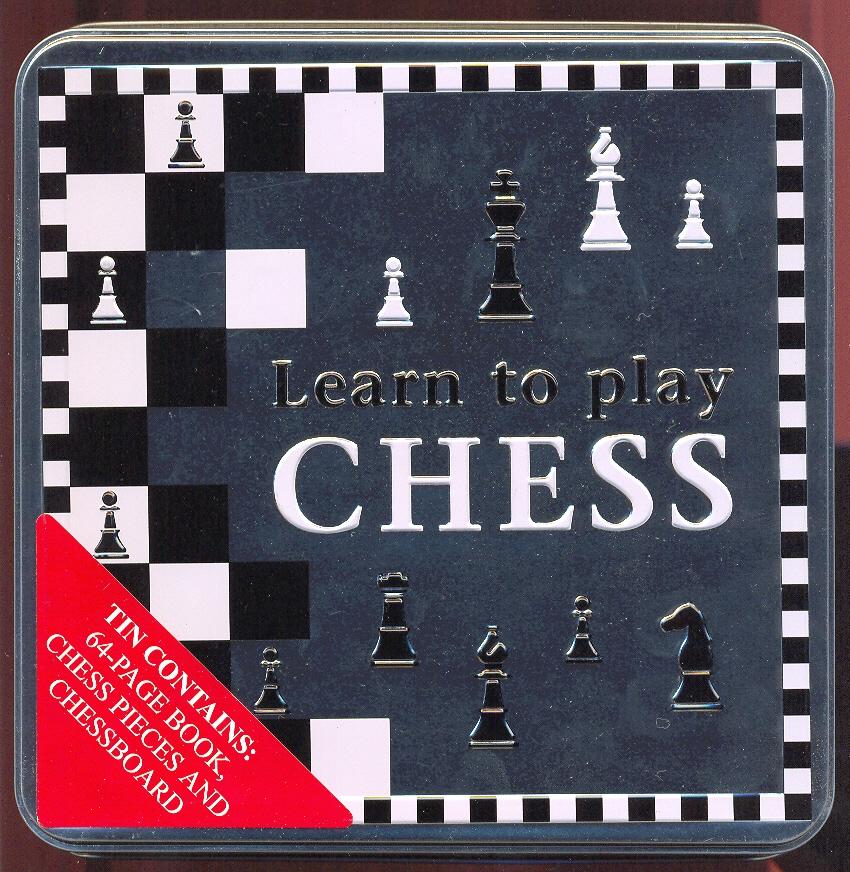
The board and pieces, in particular, are of rudimentary quality, yet the price of the complete item, available from Amazon, may be regarded as a marketing miracle: £4.79, or about 7 Euros. At a similar (or even lower) price, German and French editions have also appeared, although in smaller, cardboard packaging.
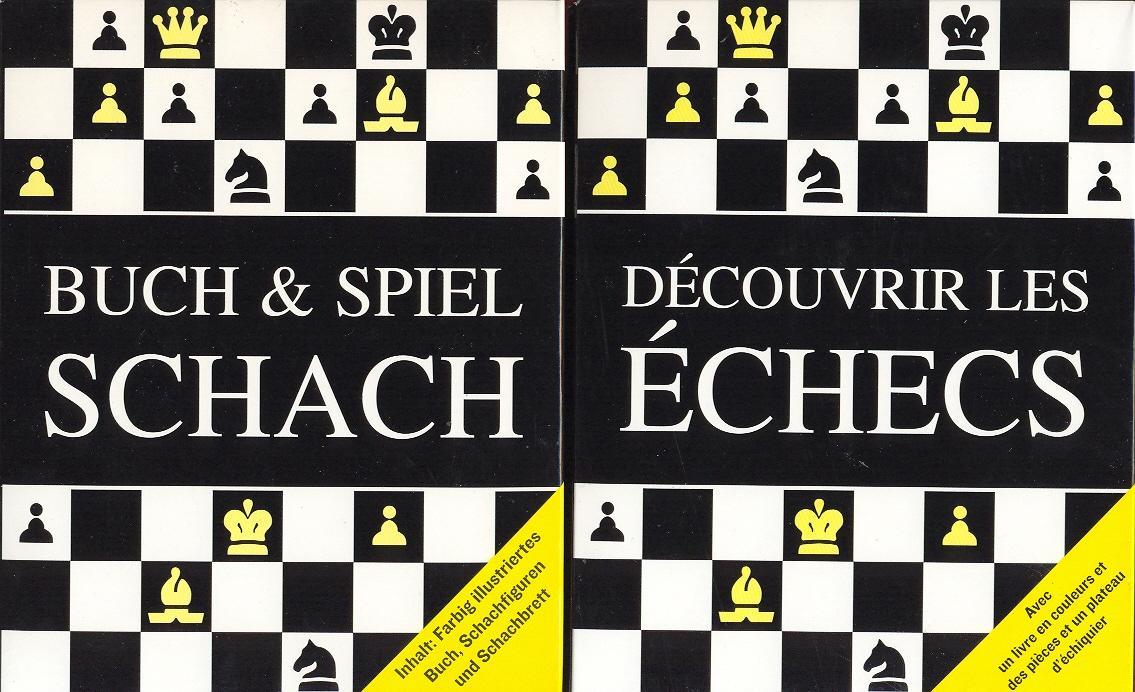
The publisher is Parragon, Bath, England.
Neil Brennen (Spring City, PA, USA) has found another Starbuck game:
James Grundy – Daniel F.M. Starbuck
Offhand game, Manhattan Chess Club, New York, 1879
Two Knights’ Defence
1 e4 e5 2 Nf3 Nc6 3 Bc4 Nf6 4 Ng5 d5 5 exd5 Na5 6 Bb5+ c6 7 dxc6 bxc6 8 Be2 h6 9 Nf3 e4 10 Ne5 Qd4 11 f4 Bc5 12 Rf1 O-O 13 c3 Qd8 14 b4 Nd5 15 bxc5 Qh4+ 16 Rf2 Qxh2 17 d4 e3 18 Rf3 Qg1+ 19 Bf1 f6 20 c4 fxe5 21 cxd5 exf4 22 Bxe3 fxe3 23 Rxf8+ Kxf8 24 Qf3+ Kg8 25 Nc3 Bg4 26 Qf4 Rf8 27 White resigns.
Source: Cincinnati Commercial, 29 December 1879.
We now note that the Winz v Czerniak game was published on pages 331-332 of The Fireside Book of Chess by I. Chernev and F. Reinfeld (New York, 1949), where it was described as ‘one of the most entertaining games ever played’. The finish was given as follows: 41 Re8 (‘A parting joke: if 41...b1(Q)?? 42 Rg8+!! Kxg8 43 Re8+ Kg7 44 Rg8+ and White will draw by stalemate with two queens down.’) 41...Qxe3+! 42 White resigns.
From José Fernando Blanco (Madrid):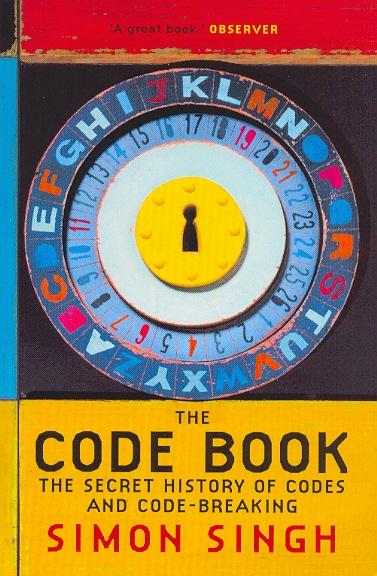
‘I have been reading an excellent work, The Code Book by Simon Singh, first published in 1999 and with a paperback edition issued in 2000. It describes various historical and current aspects of ciphering and deciphering messages, and one of the chapters deals with the activities of the British intelligence services during World War II, which proved crucial for the Allies’ victory. I quote from page 178 the author’s description of the bizarre mixture of people involved in deciphering enemy messages:
“... in addition to the mathematicians and linguists, there was an authority on porcelain, a curator from the Prague Museum, the British chess champion and numerous bridge experts.”The chess champion is not named, but it would seem to be C.H.O’D. Alexander, who had won the most recent championship, in 1938.
The following page quotes from a letter dated 21 October 1941 written by some of the criptanalysts to the British Prime Minister, Winston Churchill, to appeal for additional staff. It was signed by A.M. Turing, W.G. Welchman, C.H.O’D. Alexander and P.S. Milner-Barry. Churchill immediately issued a positive response.
Milner-Barry (“one of the Hut 6 cryptanalysts”) is cited as follows on page 186:
“I do not imagine that any war since classical times, if ever, has been fought in which one side read consistently the main military and naval intelligence of the other.”’
For another detailed discussion of the work of the Bletchley Park code-breakers, together with the complete text of the letter to Churchill (which was marked ‘Secret and Confidential. Prime Minister only’), see The Essential Turing edited by B. Jack Copeland (Oxford, 2004).
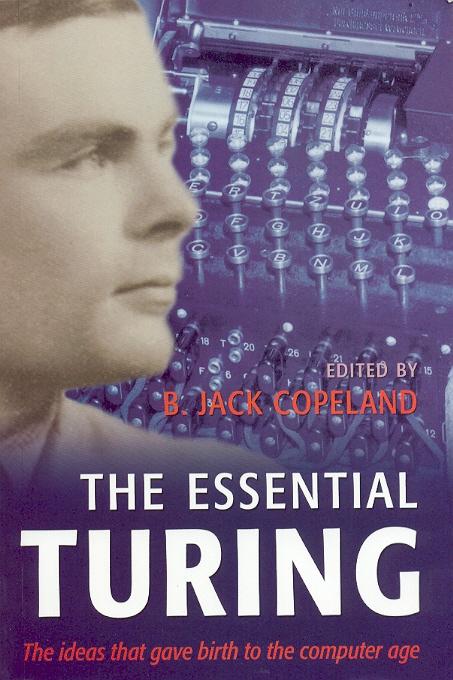
P.S. Milner-Barry wrote about his and Alexander’s code-breaking work on pages 3-5 of Golombek and Hartston’s The Best Games of C.H.O’D. Alexander (Oxford, 1976) and included the following tantalizing comment:
‘Much has been written lately about what came out of Bletchley, but only from the point of view of the user. Security restrictions on the story of the breaking of the Enigma from the technical point of view have not yet been lifted. I still hope that they may be in my time. It would, I believe, make an enthralling story which would be particularly fascinating to chessplayers. For both Hugh and myself it was rather like playing a tournament game (sometimes several games) every day for five and a half years.’
Milner-Barry lived until 1995. Dare it be hoped that he wrote up his recollections of the 1940s?
Harry Golombek, who died the same year as Milner-Barry, was also at Bletchley Park. In his obituary of Jacob Bronowski on pages 441-443 of the December 1974 BCM he recalled being heartily recommended to an Intelligence Department of the Foreign Office by his artillery commanding officer on the grounds that ‘I had too much brains to be behind the guns’. On page 131 of his Encyclopedia of Chess (London, 1977) Golombek stated that he was at Bletchley Park ‘like Alexander, Milner-Barry and quite a number of other chessplayers’. Who were the others?
We note, finally, the following on page 162 of Simon Singh’s book:
‘Initially, Bletchley Park had a staff of only two hundred, but within five years the mansion and the huts would house seven thousand men and women.’
From page 149 of How to Play Chess Like a Champion by F. Reinfeld (New York, 1956):
‘Staunton was pompous and bombastic, a self-appointed dictator of the chess world. On one occasion a rival published a statement that he had won the majority of his games with Staunton. The next time they met Staunton thundered, “You can’t print that!” His rival stammered feebly that the statement was true. “What’s that got to do with it? Of course it’s true!”, Staunton raged. “But you still can’t print it!”’
In C.N. 1624 (see pages 132-134 of Chess Explorations) we quoted Chernev’s version of the anecdote in The Bright Side of Chess, as well as a (significantly different) account by G.A. MacDonnell in the Illustrated Sporting and Dramatic News. In both cases Staunton’s rival was named as Löwenthal. Do any other nineteenth-century sources discuss the alleged episode?

This position arose on 25 November 1962 in a game between C.J.S. Purdy and O. Sarapu on board one of a match by teleprinter between Sydney and Auckland. We quote from pages 16 and 32 of Chess World, February 1963:
‘At the suggestion of Lajos Steiner, the Sydney player [Purdy] was required to demonstrate a win, but he only found time for a little perfunctory analysis which Sarapu could not admit as adequate. As Sarapu is in regular correspondence with Grandmaster Paul Keres, he suggested that he send the position to him to look at, and Purdy naturally jumped at this.
Keres very kindly did look at it, in response to a request from his old friend (they were at school together – we mention this because it would be a solecism to make such a request without a background of this sort). Naturally Keres was not prepared to adjudicate officially, “but”, writes Sarapu, “the variations he shows have convinced me clearly that there is nothing I can do against them.” Accordingly Sarapu admits the game as a loss ...
Keres’ analysis seems so simple that we feel a bit ashamed of not having worked it out even in the short time we permitted ourselves to look at it. In a correspondence game we would no doubt have found it, but equally certainly would have taken a good deal longer than Keres. Readers may like to have a shot themselves. At first sight it seems impossible for White to avoid a draw; not only is it not impossible but Keres shows two ways, though both lead up to the same idea.
... Keres’ winning plan is very simple. White must build a position with g3 and h4, so that if he got both rooks on the seventh and could evade perpetual check, he could mate at h7. So the problem is only to get his king to h2 in that position and his king’s-side rook either to e2 or f2, then play d8(Q), allow Black to take the queen and then double on the seventh rank. Black can then check once, and that is all.
Keres gives two lines that lead to the win. The simpler is 1 Kh2 Qd6+ 2 g3! Qd2+ 3 Kg1 Qd1+ 4 Kf2 Qd2+ 5 Re2 Qd3 (say).
All White has to do then is first to protect his rear rook by playing it to b2, then march back with his king to h2; then play h4; then play his rook back to e2 or f2, whichever is available; then queen the pawn and after ...Qxd8 the final kill by doubling on the seventh. All this assumes that Black has not meanwhile chosen to lose by ...g5.
The second and slower way of doing it starts with 1 Kh2 Qd6+ 2 Kg1 Qd1+ 3 Kf2 Qd2+ 4 Re2.
In the first line, suppose Black comes out with his king, e.g. 6 Reb2 Kg5 7 Kg2 Kf6 (nothing else makes much sense) 8 Rf2+ Ke6 (if 8...Ke7 he gets mated) 9 h4, and White is threatening Rf8. Black can win a rook but then White queens. Nor will ...Qd6 help as White then has Re2+ and Re8. In other words, bringing out the king is only frying-pan to fire.
White has no need to hurry. Using the advanced passed pawn to keep the black queen semi-tied, White can slowly weave his web.’
Most of the game itself had been given on pages 150-151 of the September [sic] 1962 Chess World: 1 d4 Nf6 2 c4 c5 3 d5 e6 4 Nc3 exd5 5 cxd5 d6 6 e4 g6 7 Nf3 Bg7 8 Nd2 O-O 9 Bd3 Re8 10 O-O Na6 11 Nc4 b5 12 Nxb5 Nxe4 13 f3 Nf6 14 Ncxd6 Re7 15 Bc4 Bd7 16 Nc3 Qb6 17 Nde4 Nxe4 18 Nxe4 Bb5 19 Qb3 Nb4 20 Be3 Qa6 21 Bxb5 Qxb5 22 Rac1 Qe2 23 Bxc5 Rxe4 24 fxe4 Nd3 25 Rc2 Qxe4 26 Qb7 Re8 27 Qxf7+ Kh8 28 Kh1 Nxc5 29 Rxc5 Rf8 30 Qxf8+ Bxf8 31 Rxf8+ Kg7 32 Rf1 Qd4 33 Rfc1 Qxb2 34 d6 Qe2. ‘There now followed some tedious repetitions and other manoeuvres, White requiring to gain time on his clock, and the final position on move 50 was as diagrammed [above] ...’
Alan McGowan (Waterloo, Canada) has the following Kurt Richter games in his collection:
Ahues v Richter
Berlin-Freien Turnier-1st Class, 1925
1 d4 b5 2 e4 Bb7 3 Nd2 a6 4 c3 e6 5 Ngf3 d6 (½-½, 46)
Source: Deutsches Wochenschach, 1925, pages 52-53.Helling v Richter
Berlin Championship, 1926
1 d4 b5 2 e4 Bb7 3 Bd3 Nf6 4 Qe2 e6 5 f4 Nc6 6 Nf3 (0-1, 33/34)
Source: Kurt Richters Beste Partien by A. Brinckmann (1939 and 1961 editions).Grammatikoff v Richter
Berlin Championship, 1936
1 d4 b5 2 e4 Bb7 3 f3 b4 4 Be3 e6 5 Nd2 f5 6 Bd3 Nf6 (0-1, 40)
Source: Kurt Richters Beste Partien by A. Brinckmann (1939 edition).Lehmann v Richter
Willi Schlage Memorial Tournament, Berlin, 1940
1 d4 b5 2 a4 b4 3 c4 Nf6 4 Nf3 Bb7 5 g3 c5 6 Bg2 (1-0, 41).
Our correspondent adds:
‘Kurt Richter played ...b5 on many other occasions, although most such games opened 1 d4 Nf6 2 Nf3 b5. Flohr v Richter, Poděbrady, 1936 began 1 Nf3 b5 (½-½, 21).’
Mr McGowan mentions that Raaphy Persitz annotated Winz v Czerniak in his ‘Student’s Corner’ column in the BCM (June 1960 issue, pages 176-179) and that Gerald Abrahams discussed the game on pages 193-199 of The Pan Book of Chess (London, 1965), a work which also appeared the same year in hardback as The Handbook of Chess.
Persitz’s notes concluded:
‘The tensest and most exciting game played on Israeli soil ever since Joshua crossed the Jordan several thousand years ago.’
A further contribution from Mr McGowan:
‘See CHESS, February 1945, page 73, for a report of a 12-board match on 2 December 1944 between Oxford University Chess Club and Bletchley Chess Club. The Bletchley team (which won 8-4) included C.H.O’D. Alexander and H. Golombek on boards 1 and 2. Board 3 featured J.M. Aitken, board 4 was I.J. Good, and board 5 was occupied by N.A. Perkins. Full team details were given, as well as a photograph of the players:
An article based on this information was published on pages 10-11 of Scottish Chess, June 2005.’
Milner-Barry was not mentioned in the CHESS report. As regards his surviving papers, Leonard Barden (London) draws our attention to their location.
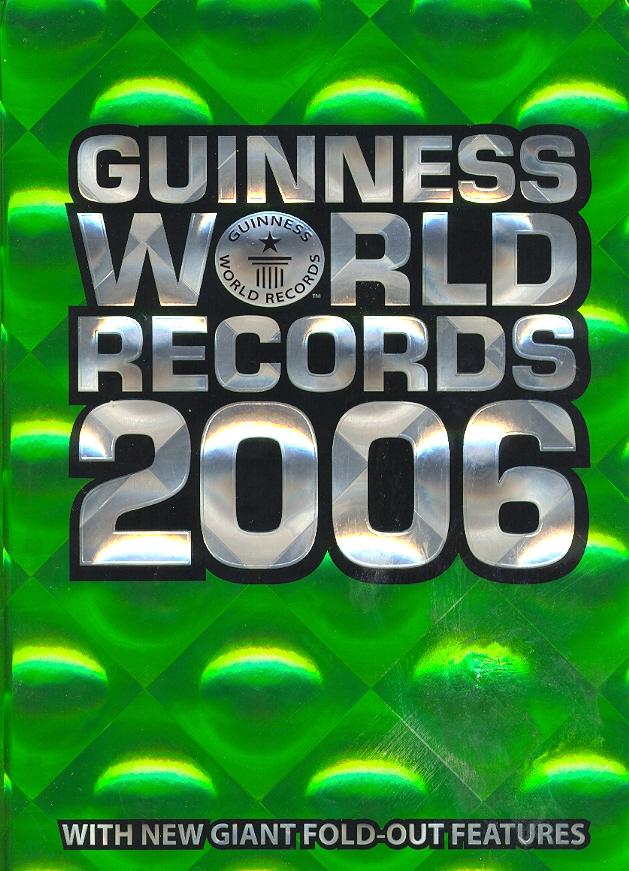
C.N. 3493 was critical of the chess coverage in Guinness World Records 2005, and we now have before us the 2006 edition. Treatment of chess is still a far cry from what the book offered in past decades, but a modest start has been made in the right direction, with a chess section (page 46) comprising the following four items:
The book’s cut-off point seems to be spring 2005 for the inclusion of records and about 15 for the age of readers targeted.
In C.N. 3973 we mentioned G.H. Diggle’s high praise of ‘Excuses for Losing Games’ on pages 191-200 of Chess Life-Pictures by G.A. MacDonnell (London, 1883). Below is the full essay:
‘The excuses made by chessplayers for making bad moves and losing games are of wonderful diversity. Sometimes they are ingenious and even rise to the height of considerable imaginative power.
First let me notice the pre-prandial and post-prandial excuses. At one time it is, “I cannot play because I have not had my dinner”; and at another time, “I cannot play because I have had my dinner.” I have never yet had the good or the ill fortune to engage one of these gentlemen at the particular time when his chess powers were in real working order; and as all time must either precede or follow dinner, I am at a loss to conceive when such a player can conduct his game in a manner satisfactory to himself.
I had a venerable cousin some years ago who enjoyed a considerable reputation as a player by correspondence. On one occasion I encountered him over the board. It was winter time and very cold. We were unable to get seats near the fire, and my opponent being very slow in his moves, I employed some of my leisure moments in wandering about the room, gazing at the boards of neighbouring players, and stopping at times to warm myself by the fire After a hard fight of some hours’ duration I won the game. My relative then challenged me to a second battle. The opening, I remember, was to be the same as in the first – an Evans gambit conducted by me, and compromisedly (very much so, indeed) defended by him. He was slower than ever, and once more I betook myself to the hearth. He glanced at me fretfully two or three times whilst cogitating over his move, and at length called me to him, and said authoritatively –
“I must request you to resume your seat and not leave it again until the game is over. I lost the last game owing to your wandering about the room and distracting my attention. I can never play without having my opponent sitting opposite me.” I begged his pardon and, as he was old, I obeyed his orders.
A favourite excuse with Mr O. for weak moves and lost games was, “My dear sir, I cannot attend to chess; I have my house and other fish to fry”, as though he were handicapped too heavily by having to fight a man who either lived all his life in the open air or, at best, in lodgings, and who never had cod or salmon dressed in the manner specified. By-the-bye, that was a strange excuse which Staunton made to an admirer of his for losing his match at pawn-and-two moves with Lowe:
“You see, sir, the odds were too little; I could not play my best. I ought to have given him the knight.”
I am happy to say the old headache excuse has long since been worn to shreds; so much so that no player, in London at all events, has the shamelessness to put it forward. But I do sometimes hear a man say when losing, “I can’t play today. I didn’t get to bed last night until 12”; or, “No wonder I make such blunders; I was travelling by rail for two hours yesterday.”
I remember a distinguished player, no longer resident in London, who used to say, “I can’t help making mistakes when I play with Barnes. Whenever I lay a trap, or make a good combination, he has a habit of taking his cigar from his mouth, raising his eyes from the board, and glancing at me in a peculiarly furtive and knowing manner, as much as to say, ‘Surely you don’t expect to catch me in that way? No, my boy, I am a deal wiser than you fancy – in fact, wiser than yourself’.”
At the Westminster Chess Club some years ago I used to give the odds of queen to a young friend who had special talents, but not for chess. I don’t know why, but I always played to trap his queen, and seldom failed to do so; and he accounted satisfactorily to himself for his weak play and constant defeats by the mortal dread of losing his queen that seized him from the very beginning of the game. But he used to get his revenge out of me by asking me the following puzzle, which I never could solve: “Can you tell me why it is that I always lose my queen?”
Dear Mr E., whom everybody loves to see playing, ascribes his occasional failures to his inability to swallow other men’s smoke, especially when it is whirlwinded up his nose or down his back.
In my young days I sometimes played an old gentleman to whom I gave large odds and generally a beating. He never would resign until he was checkmated, nor would he accept your resignation until the final coup was administered. His excuse – his constant excuse was that he could not play because people would open the door so often, and creak its hinges. One day, I remember well, it thundered, and on that occasion only did he vary his excuse, charging the atmosphere with his misfortunes.
The door is a constant source of annoyance to some players. A member of the Westminster Club, a good-tempered fellow and excellent in all social ways, used, when playing, to expend a great portion of his time in watching the door, and if anyone left it wholly or partly open he would rush from his seat and close it with a bang, muttering to himself at the same time words which no mortal would particularly care to hear.
Everyone – well, nearly everyone – knows Toun. I believe he has frequented the Divan for the last 50 years, and I sincerely hope he may spin out the period of his attendance to a century. He delights in chess and is a strict observer of the rules of the game. He is rich, and insists upon playing for the usual stake. He never accepts of any but the following trifling odds: choice of colour and of seats, first move, the draws, and three to one! He never allows any person to speak a word, much less make a suggestion, at his board, and glares ferociously at any good player who even stops for a moment to glance at the position of his game. I once happened to be at the next table to that at which he was playing. He lost, and immediately began to complain. To do him justice, I must say he never complains but when he has thrown away a won game. Thus did he explode: “I’ll play no more! I can’t play with Captain Cunningham making such a hideous noise!” “I?”, said the captain. “Why, I never opened my lips during the game.” “No, sir, I know you did not; but you were breathing hard!”
“I cannot play with the black men, and so no wonder I have lost.” Now this excuse in itself is childish, because a practical, not to say a good, player ought not to let his skill be affected by the colour of the pieces he manipulates. One colour is as good as another for practical purposes, unless it be of such a bright and flaming nature as to dazzle the eyes; and although the position of the forces, especially as regards castling, differs slightly according to the colour of the pieces you are playing, yet a player who claims any reputation for himself ought to have mastered the geography of the board as to be indifferent whether his men are black or white. This excuse, moreover, is based upon no reasonable grounds. You accustom yourself to do what you ought not to do. You acquire a bad habit; a habit which you must know will some time or other prove inconvenient to yourself or your opponent; and then you plead that habit as a reason why your bad play ought to be excused, or your opponent’s merit in winning be depreciated. Surely such an argument is illogical, such a contention unfair. The remedy for this evil habit is simple and easy. Play as much with the black as with the white men. Be just even to all colours. Observe as little distinction between the colour of chess pieces as that of men in your practical treatment of them.
A funny, but by no means stupid, excuse for playing badly was lately made by a young provincial friend of mine. He visited a club where I happened to be present, and sat down to encounter a fifth-class player. After the fight had lasted some time, I sauntered up to the board and asked my young friend how he was getting on. “Oh”, said he, “very badly. I cannot play with these pieces, they are so unlike those to which I am accustomed; they are horrible.” “What”, enquired I, “is the matter with them?” “Well”, replied he, “several of the pieces, especially the kings and queens, are too like one another; they are not sufficiently distinguished.” “True”, I rejoined, “but they are quite as distinguished as the players.”
An old friend asked me the other day, “Have you never yourself made excuses for losing games?” In answer to this question I may say I never, well, hardly ever, make excuses, but I sometimes assign reasons. Here is one. A long time ago I accidentally lost a game in this way. My opponent had a cruel taste for music, and manifested it in a manner peculiarly disagreeable to me. Throughout the whole contest he never ceased to hum, except when he began to beat time with his finger on the board – in other words, to drum. Now, being lively in my disposition, and not unmusical in my taste, my friend’s noisy performances irritated my nerves and distracted my attention. That hum-drum game was more than I could bear and, consequently, I lost it.
The celebrated Agamemnon has certainly won some games of me, not so much by his superior skill as by hovering with his hand over the pieces and never moving the piece he plays to any definite square, so that a good portion of my time is wasted in watching to see what piece he has touched and in re-adjusting the pieces when he has completed his move.
A novel and ingenious excuse was lately given by Ajax for losing a match game to Hector. “He bothered me thus: every time I made a move he pulled out a large black note-book, wherein he recorded my move before making his own. That black note-book was to me what the great black horse that would follow, or might have followed, Mr Pickwick was to him - a bête noire; it disconcerted my thoughts, it struck terror into my heart.”
Some persons fairly attribute their bad moves to the light. They cannot play if they happen to have the sun in their eyes. Others cannot play with their backs to the light. Some persons are injuriously affected by gas, and I know at least one first-class player who can play about a pawn and move stronger when he has the sunlight. I know several players who find it impossible to do justice to their powers if they have to play in a room ill-ventilated or over-heated. There is no doubt that in many cases such a condition of things is calculated to dim the vision and cloud the brain. It has always seemed marvellous to me how some players can play as well in a vitiated as in a pure atmosphere. I remember encountering Menelaus about three years ago. We played in a small room lit by a large gaselier and in presence of about eight spectators, who were all smoking, as also was my opponent. Menelaus wore a top coat and, as well as I remember, a muffler. Frequently I rushed out of the room to catch a mouthful of fresh air, purposely leaving the door open behind me; but as I observed that my opponent always rose to shut it, I was obliged to relinquish this mode of obtaining relief. Now in such cases as those I have enumerated, satisfactory causes can be assigned for making bad moves, but still I hold that the wisest course for a man to adopt when defeated is to hold his tongue and look pleasant. This course is no doubt trying to the temper, as an opponent is often unduly exultant over a victory in which he has had auxiliaries of whose existence he has been wholly unconscious.’
Our copy of G. MacDonnell’s 1883 book Chess Life-Pictures has inscriptions from H. Gastineau to J. Walter Russell and from Russell to Ellen Sparks:
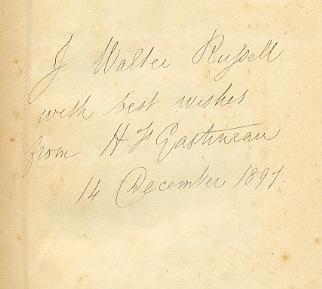
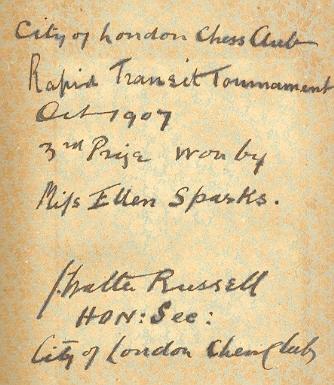
Joseph Walter Russell (1849-1931), a controversial figure in his time, is largely forgotten today. He was, though, mentioned on page 154 of The Unknown Capablanca by D. Hooper and D. Brandreth (London, 1975) in connection with a simultaneous exhibition given by the Cuban in 1919:
‘In his third and last display at the City of London Chess Club Capablanca did better than before as he had promised; but the club had lost its former strength. The secretary, J. Walter Russell, was a sick man, suffering from xenophobia; he had expelled many talented players and not until 1927 were foreigners again permitted to join. A few years later this famous club faded away.’
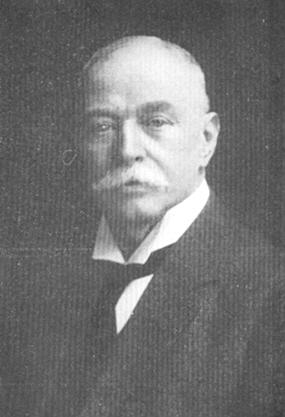
Joseph Walter Russell
Biographical details about Russell appeared on pages 165-166 of the May 1929 BCM (where the portrait above was also given) and in his obituary on pages 127-129 of the March 1931 issue. It was reported there that he had joined the City of London Chess Club in 1889 and was its honorary secretary from 1895 until May 1930. The BCM remarked in 1929: ‘For length of service, breadth of ability and depth of devotion Mr Russell’s record must be almost without parallel and his name will ever be coupled with that of the club he has made so famous.’ His obituary, however, also referred to a darker side:
‘Of course Mr Russell’s best friends will recognize that he had the defects of his qualities. His fervent patriotism, his innate conservatism and his unquestioning love of the club made him rather prejudiced against “foreigners”, people of different political views from his, and institutions which appeared to him to menace the supremacy of the “City”. He could not help his whole-heartedness, and did not care to disguise his feelings, especially as he grew older in years. The Great War did much to emphasize his strength of convictions, and led him to refusal of all compromise. But his name will be remembered, not for such matters, much rather for his intense loyalty to what he considered the best interests of chess.’
To what extent Walter Russell’s services to chess were remembered is difficult to say, but some three decades after his death he took centre stage in a controversy in the pages of CHESS when the magazine published William Winter’s posthumous memoirs. From page 29 of the 24 December 1962 issue:
‘My real chess career began when I joined the City of London Chess Club at the age of 15. This was, and had been for many years, the leading club in the country, and everybody who had any kind of chess aspiration was a member. The club met in Grocers Hall Court, off Poultry, and was ruled with a rod of iron by its secretary, J. Walter Russell. He was a real despot who would brook no kind of opposition, but there is no doubt that he did a tremendous amount of good work for the club. Later on his jingoistic attitude made him my bitter enemy, but in those early days he did everything to encourage me, and presented me with the bound volumes of the rare City of London Chess Magazine autographed by himself.’
And from page 32:
‘In these war days I did not go much to the City of London Club. Russell had already developed the jingoism which eventually drove him completely out of his mind, and I was soon at loggerheads with him. The first serious breach occurred on the question of the naturalized Germans. There was a number of these in the club, many of them British citizens since boyhood, and as loyal as Russell himself. Nevertheless, to the latter everything German was tainted, and a special general meeting of the club was called to purge the club of the abomination. Together with Scott and most of the younger and stronger players I vigorously opposed the expulsion, but Russell had sent out a three-line whip to fellow dotards and, by a large majority, the naturalized Germans had to go. Among them was the club’s president, a man in his 80s, who had been a member for over 50 years. His expulsion broke his heart. He lived just long enough to alter his will, in which he had left the club a large sum of money.’
The president in question was Herman(n) Eschwege.
In subsequent issues the remarks about Russell were discussed by readers. On page 212 of CHESS, 20 April 1963 J.Y. Bell (‘I joined the City Club in 1901 so I saw something of Russell’) wrote that the most regrettable feature of William Winter’s memoirs was ‘his venomous attack on Walter Russell, whom I remember as a courteous and harmless old gentleman who devoted his life to the City of London Chess Club’. On the same page the Editor, B.H. Wood, commented: ‘We met Walter Russell personally and found him dominating and irascible’. The 25 May 1963 issue of CHESS (pages 244-245) had two contrasting views. David Hooper observed that ‘Winter, who was trying to earn a living at chess, was refused membership of the City of London Chess Club because of his political beliefs – a matter of principle not raised by your correspondent, Mr J.Y. Bell’, but Russell was defended by R.E. Robinson:
‘I was a member [of the City of London Chess Club] from 1920 to its end in 1938 and was honoured by Russell’s friendship. I remember the incident of a printer who joined for a short period and turned up with dirty hands, and perhaps Russell’s justified and outspoken indignation against this man was a pointer towards the bad feeling between Russell and Winter. Russell’s great services to chess included the organization of the 1899 London tournament, the Club’s invitation tournament of 1900, the cable matches and the Club’s 75th anniversary tournament in 1927. He was generous in financial help to impoverished British masters, and I hold a document which shows that he gave £1 to a hard-up German master – quite a lot of money 50 years ago. ... All in all he was a fine old English gentleman and Winter’s uncharitable words were quite unworthy of him.’
Two general articles on the City of London Chess Club may be mentioned here: on pages 1-17 of the January 1893 BCM and on pages 9-11 of the Chess Amateur, October 1906. The photograph below appeared opposite the first page of the January 1898 BCM:
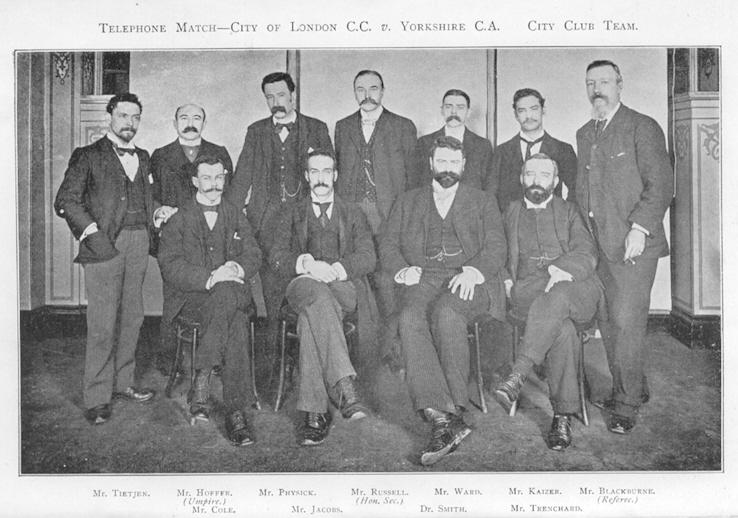
Harrie Grondijs (Rijswijk, the Netherlands) has found the following game:
Daniel F.M. Starbuck (blindfold) – H.F. Cooke
Chicago, 1883
Evans Gambit Accepted
(Notes by Starbuck)
1 e4 e5 2 Nf3 Nc6 3 Bc4 Bc5 4 b4 Bxb4 5 c3 Ba5 6 d4 exd4 7 O-O Bb6 8 cxd4 d6 9 d5 Na5 10 Bb2 Ne7 11 Bd3 O-O 12 Nc3 Ng6 13 Ne2 c5 14 Rc1 Bc7 15 Ng3 Rb8 16 Qd2 f6 (‘The right move. White threatened to take on g7 with the bishop, followed by Nh5+, etc.’) 17 Nf5 b5 18 Kh1 c4 19 Be2 Nb7 (‘Again the correct move.’) 20 N3d4 Bd7 21 f4 Nc5 22 Qe3 Re8 23 Ng3 Bb6 24 f5 Ne5 25 Nh5 Ned3
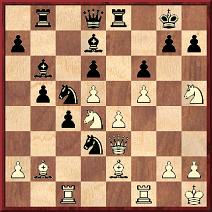
26 Nxg7 (‘Well worth the trial, even if it will not stand cold-blooded analysis.’) 26…Kxg7 (‘Probably 26…Nxb2 would have offered more resource to Black, but at all events White would have gained a rook and two pawns with some attack, for the two minor pieces.’) 27 Bxd3 Nxd3 28 Ne6+ Bxe6 29 Qg5+ Kf8 (‘Best.’) 30 Bxf6 Qc7 31 fxe6 Nf2+ 32 Rxf2 Bxf2 33 Rf1 Re7 (‘The game is past saving; the move simply delays mate.’) 34 Bxe7+ Qxe7 35 Rxf2+ ‘and mates in two’.
Our correspondent’s source is the St Louis Globe-Democrat, 1884; an earlier, more precise one is being sought.
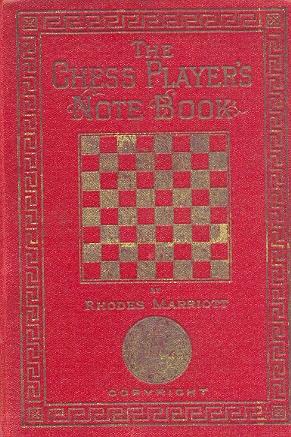
A bibliographical rarity is The Chess Player’s Note Book by Rhodes Marriott (Manchester, 1884 and 1901), which is essentially a blank score-book. Our copy of the 1901 edition belonged to a player who identified himself only by the initials ‘J.H.M.’ and whose games included draws against Capablanca and Menchik in simultaneous exhibitions in the mid-1930s. The decisive clue to identifying ‘J.H.M.’ was his game against Capablanca (in Manchester, 1935). As noted on page 75 of the February 1935 BCM, on 7 January that year the Cuban scored +39 –0 =1. The player who drew was not named, but the extensive report on page 4 of the Manchester Evening News, 8 January 1935 identified Capablanca’s opponent as J.H. Mandleberg, ‘who is his host for his Manchester visit’. Below is the game, as recorded in the score-book:
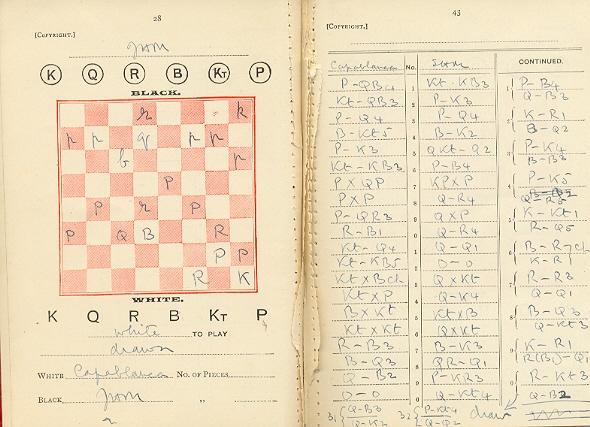
J.R. Capablanca – J.H. Mandleberg
Manchester, 7 January 1935
Queen’s Gambit Declined
1 c4 Nf6 2 Nc3 e6 3 d4 d5 4 Bg5 Be7 5 e3 Nbd7 6 Nf3 c5 7 cxd5 exd5 8 dxc5 Qa5 9 a3 Qxc5 10 Rc1 Qa5 11 Nd4 Qd8 12 Nf5 O-O 13 Nxe7+ Qxe7 14 Nxd5 Qe5 15 Bxf6 Nxf6 16 Nxf6+ Qxf6 17 Rc3 Be6 18 Bd3 Rad8 19 Qc2 h6 20 O-O Qg5 21 f4 Qf6 22 Kh1 Bd7 23 e4 Bc6 24 e5 Qh4 25 Kg1 Rd4 26 Bh7+ Kh8 27 Rh3 Qd8 28 Bd3 Qb6 29 Kh1 Rfd8 30 Rg3 Qc7 31 Qc3 Qe7 32 b4 Qd7 Drawn.

The Manchester Evening News gave two of Capablanca’s wins:
J.R. Capablanca – W. Coombs
Manchester, 7 January 1935
Caro-Kann Defence
1 e4 c6 2 d4 d5 3 exd5 Qxd5 4 Nc3 Qa5 5 Bd2 Qb6 6 Nf3 Bg4 7 Bc4 e6 8 O-O Bxf3 9 Qxf3 Qxd4 10 Qe2 Nf6 11 Rfd1 Qg4 12 f3 Bc5+ 13 Kh1 Qf5
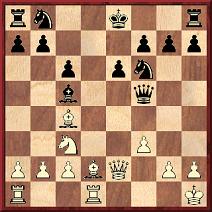
14 g4 Qxc2 15 Rdc1 Qxb2 16 Rab1 Qa3 17 Rb3 Qa5 18 Ne4 Qc7 19 Nxc5 O-O 20 Rxb7 Qd6 21 Bb4 Re8 22 Rd1 Nd5 23 Ne4 Qf4 24 Bxd5 cxd5 25 Bd6 Qh6 26 Qb5 Nc6 27 Qxc6 dxe4 28 Qxe4 Rac8 29 Bf4 Qh3 30 Be5 Rcd8 31 Qe2 Resigns.
J.R. Capablanca – F. Evans
Manchester, 7 January 1935
Queen’s Gambit Declined
1 c4 e6 2 Nc3 Nf6 3 Nf3 d5 4 d4 Nbd7 5 Bg5 c6 6 e3 Qa5 7 cxd5 Ne4 8 dxe6 Nxg5 9 exd7+ Bxd7 10 Nxg5 Qxg5 11 Qb3 Bc8 12 Ne4 Qa5+ 13 Nc3 Bb4 14 Bd3 O-O 15 O-O Be6 16 Qc2 f5 17 Ne2 Bd6 18 Bc4 Bxc4 19 Qxc4+ Kh8 20 g3 Qd8 21 Rfd1 Qe7 22 d5 cxd5 23 Rxd5 Rad8 24 Rad1 Bc7 25 Rxd8 Rxd8 26 Rxd8+ Bxd8 27 Nd4 g6 28 Qc8 Qc7
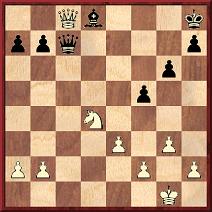
29 Qa8 Qb6 30 h4 h5 31 Ne6 Qxe6 32 Qxd8+ Kg7 33 Qc7+ Kh6 34 Qb8 Resigns.
The newspaper reported that Capablanca’s 40 opponents comprised ‘38 men, one woman and one schoolboy’. The youngster was Fred Mellor, aged 12, of Withington.
From Calle Erlandsson (Lund, Sweden):
‘The mathematician Arne Beurling (1905-1986) worked with the botanist and correspondence chess grandmaster Åke Lundqvist (1913-2000) on breaking the Geheimschreiber code. Professor Beurling had already solved several Russian crypto systems in 1939-40. After the occupation of Norway in 1940 the Germans insisted on using the Swedish west-coast cable system for telephone and telegraphic traffic. Sweden naturally made formal protests, but it did mean that Sweden could construct a bugging cable to Stockholm. Beurling and Lundqvist understood that there was a machine involved, the Siemens Geheimschreiber, and they eventually broke the code.
The Geheimschreiber
Bengt Beckman wrote a book about the code-breaking Swedes, which was also published in English in 2003 by the American Mathematical Society: Codebreakers: Arne Beurling and the Swedish Crypto Program During World War II.
Lundqvist played only 87 correspondence chess games in his career (1944-76), with a score of +43 – 12 =32; he was Swedish correspondence champion in 1945. He took part in the world championship finals II-IV, finishing fourth, third and eighth respectively. An obituary of him was published on pages 31-45 of the 6/2000 issue of Korrschack.’
Peter de Jong (De Meern, the Netherlands) sends the following curious game from a simultaneous exhibition:
Max Euwe – N.N.
Brazil, 1947
French Defence
1 e4 e6 2 d4 d5 3 Nd2 Nc6 4 Ngf3 dxe4 5 Nxe4 Be7 6 c3 Nf6 7 Bd3 O-O 8 O-O Bd7 9 Nfg5 g6 10 Qf3 Kg7 11 Qh3 e5
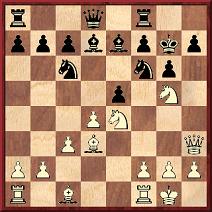
12 Qh6+ Kxh6 13 Ne6+ g5 14 Bxg5+ Kg6 15 Nxf6+ e4 16 Bxe4 mate.
Source: Euwe’s column in the July 1947 issue of the Dutch magazine De Uitkijk, from a scrapbook in our correspondent’s possession.
Euwe wrote in the column that he spoke no Portuguese but learned three sentences before his tour began. With every exhibition he added an extra line to his speech, and during his last display, in São Luiz do Maranhão, he used his entire collection of sentences, to loud applause. The next day he read a report in the local newspaper that he had thanked the audience in Spanish.
C.N. 4003 referred to a report that Zukertort had won a game in Bradford against Mark Dawson wherein he specified the pawn with which he would compel his opponent to mate him. Paul Valois (Leeds, England) has now found that the game was mentioned, although not given, in the Bradford Observer Budget of 22 November 1884. Zukertort obliged Black to mate with his pawn at a7.
The game was played on 20 November, and the same day Zukertort composed the following problem, dedicated to Alderman F. Priestman, the President of Bradford Chess Club:
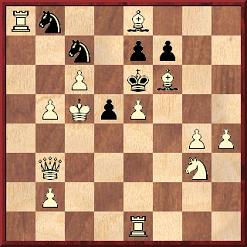
Mate in two.
Key: 1 exd6+ (since Black’s last move must have been ...d7-d5).
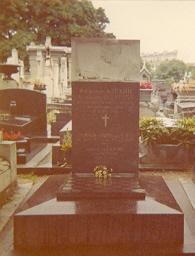
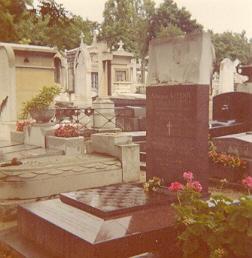
Below is the report by ‘J.A.S.’ (Jakob Adolf Seitz) on page 220 of CHESS, 28 April 1956:
‘In memory of the tenth anniversary of the death of the late world champion Alexander Alekhine, several hundred people – more than one would have expected on an icy cold day – gathered outside the main entrance to Paris’s famous Montparnasse cemetery, just before eleven in the morning of 25 March 1956.
Folke Rogard, President of the International Chess Federation, was one of the first to arrive. Soon there came a strong delegation from the USSR led by grandmaster Ragozin. Some unkind tongues suggested that the Russian chessplayers were the main attraction of the ceremony to many locals; and certainly Smyslov, Keres, Bronstein, Geller, Petrosian and others were energetically pestered for autographs.
At 11 a.m., which was said to have been the hour of Alekhine’s death, the crowd moved to the monument.
We found that Abraham Baratz, a gifted sculptor, many times chess champion of Paris in his younger days, had chiselled a statue of Alekhine in his youth sitting at a chess board. All in white marble; and it was to be noted that his chessmen were not Staunton, but French, in type.
The base of the tumulus was a huge chessboard itself, though few noticed it at the time, so completely was it covered by wreaths, of which the Soviet delegation’s was the biggest. Beneath the sculpture appeared first Alekhine’s name in his native Russian characters, then the inscription “Alexandre Alekhine, génie des échecs de Russie et de France, 1 novembre 1891 – 25 mars 1946” and below “Grace Alekhine née Wishar 1876-1956”.
On the socle of the tumulus was an announcement that the monument had been erected on 25 March 1956 by the International Chess Federation. The names of Rogard (Sweden), Ragozin, Berman (France), Botvinnik (who was not present), Count dal Verme (Italy) and others followed.
Among French chessplayers present were Dr Bernstein, C. Boutteville (present French champion), Biscay, Halberstadt, Mme Chaudé de Silans, Muffang, Ségal and others. Edmond Lancel had come from Brussels. Rogard gave a brief address in French, Ragozin another in officially translated Russian. Alekhine’s son responded, followed by Mme Isnard, a daughter of Alekhine’s last wife. The chessplayers then repaired to a famous restaurant, where a hundred anecdotes about Alekhine were exchanged. Not one word about this impressive ceremony did I find in any of the French newspapers – a sad commentary on the place of chess in France today.’
Confusion with the dates may be noted. Firstly, the date on the tombstone was ‘1 November 1892’, not 1891 (although the correct date of Alekhine’s birth is 31 October 1892). The ‘1891’ was apparently Seitz’s error and not a misprint by CHESS, because it also occurred in a similar report by Seitz on page 83 of the April 1956 Schweizerische Schachzeitung. The latter magazine, moreover, quoted Alekhine’s death-date on the tombstone as ‘25 March 1956’, instead of 25 March 1946, although the latter too was wrong. As chronicled in C.N. 3086, Alekhine was found dead in the Hotel do Parque, Estoril on the morning of 24 March 1946.
Chess Notes Archives:
| First column | << previous | Archives [16] | next >> | Current column |
Copyright 2005 Edward Winter. All rights reserved.